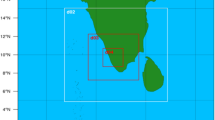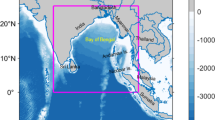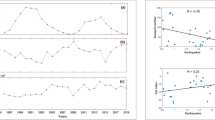Abstract
The geomagnetic storm effects on the F2-region ionospheric parameters namely, foF2 (critical frequency of the F2-region), and h'F (virtual height of the F-region) in the South Pacific region are studied in this research. The storms were selected based on their intensity measured by the Dst-index. The moderate storms are within −50 nT < Dst < −100 nT, intense storms within −100 nT > Dst > −250 nT and super storms within Dst ≤ −250 nT. Two moderate, two intense and two super geomagnetic storms were selected for this study where, foF2 and h'F data were analysed before the storm, during the storm and after the storm at selected equatorial and low latitude stations in the South Pacific Region. The variations in the foF2 and h'F parameters for the F2-region were mainly due to prompt penetration electric fields (PPEFs) and disturbance dynamo electric fields (DDEFs). The decrease in the foF2 during sudden storm commencement and the main phase onset of the storm was mainly due to PPEFs effect which lasts for few hours and later the DDEFs are main drivers for the negative and positive ionospheric trends in the recovery phase of the storm. The geomagnetic storms used in this study and the ionosonde stations in the South Pacific region were never studied before, hence, this study will be useful for the wider scientific communities and all the organizations or people who use ionosphere for communications, report space weather and satellite applications. The constant monitoring of ionosphere before, during and after the geomagnetic storms will help all the forementioned organizations and communities.






Similar content being viewed by others
REFERENCES
Astafyeva, E., Zakharenkova, I., and Alken, P., Prompt penetration electric fields and the extreme topside ionospheric response to the June 22–23, 2015 geomagnetic storm as seen by the Swarm constellation, Earth, Planets Space, 2016, vol. 68, p. 152. https://doi.org/10.1186/s40623-016-0526-x
Chen, Y. and Liu, L., Le, H., Zhang, H., and Zhang, R., Responding trends of ionospheric F2-layer to weaker geomagnetic activities, J. Space Weather Space Clim., 2022, vol. 12, no. 6, pp. 1–12. https://doi.org/10.1051/swsc/2022005
Danilov, A.D. and Laštovička, J., Effects of geomagnetic storms on the ionosphere and atmosphere, Int. J. Geomagn. Aeron., 2001, vol. 2, no. 3, pp. 209–224.
Fejer, B.G. and Scherlies, L., Empirical models of storm time equatorial zonal electric fields, J. Geophys. Res., 1997, vol. 102, no. A11, pp. 24 047–24 056.
Goel, M.K., Singh, S.S., and Rao, B.C.N., Postsunset rise of F layer height in the equatorial region and its relation to the F layer dynamo polarization fields, J. Geophys. Res., 1990, vol. 95, no. A5, pp. 6237–6246. https://doi.org/10.1029/JA095iA05p06237
Gonzalez, W.D., Joselyn, J.A., Kamide, Y., Kroehl, H.W., Rostoker, G., Tsurutani, B.T., and Vasyliunas, V.M., What is a geomagnetic storm?, J. Geophys. Res., 1994, vol. 99, no. 4, pp. 5771–5792.
Habarulema, J.B., Katamzi, Z.T., Sibanda, P., and Matamba, T.M., Assessing ionospheric response during some strong storms in solar cycle 24 using various data sources, J. Geophys. Res.: Space Phys., 2017, vol. 122, pp.1064–1082.
INGV Ionospheric Yearbook, Rome: Istituto Nazionale di Geofisica e Vulcanologia, 2013.
Klimenko, M.V., Klimenko, V.V., Zakharenkova, I.E., Ratovsky, K.G., Korenkova, N.A., Yasyukevich, Y.V., and Cherniak, I.V., Similarity and differences in morphology and mechanisms of the foF2 and TEC disturbances during the geomagnetic storms on 26–30 September 2011, Ann. Geophys., 2017, vol. 35, pp. 923–938.
Kuai, J., Liu, L., Liu, J., Zhao, B., Chen, Y., Le, H., and Wan, W., The long-duration positive storm effects in the equatorial ionosphere over Jicamarca, J. Geophys. Res.: Space Phys., 2015, vol. 120, pp. 1311–1324.
Kumar, E.A. and Kumar, S., Geomagnetic storm effect on F2-region Ionosphere during 2012 at low- and mid-latitude stations in the Southern Hemisphere, Atmosphere, 2022, vol. 13, p. 480. https://doi.org/10.3390/atmos13030480
Kumar, S. and Kumar, V.V., Ionospheric response to the St. Patrick’s Day space weather events in March 2012, 2013, and 2015 at southern low and middle latitudes, J. Geophys. Res.: Space Phys., 2019, vol. 124, pp. 584–602. https://doi.org/10.1029/2018JA025674
Kumar, S., Chandra, H., and Sharma, S., Geomagnetic storms and their ionospheric effects observed at the equatorial anomaly crest in the Indian Region, J. Atmos. Sol.-Terr. Phys., 2005, vol. 67, pp. 581–594.
Lakshmi, D.R., Veenadhari, B., Dabas, R.S., and Reddy, B.M., Sudden post-midnight decrease in equatorial F-region electron densities associated with severe magnetic storms, Ann. Geophys., 1997, vol. 15, pp. 306–313.
Lin, C.H., Richmond, A.D., Heelis, R.A., Bailey, G.J., Lu, G., Liu, J.Y., and Su, S.-Y., Theoretical study of the low- and midlatitude ionospheric electron density enhancement during the October 2003 superstorm: Relative importance of the neutral wind and the electric field, J. Geophys. Res., 2005, vol. 110, p. A12312. https://doi.org/10.1029/2005JA011304
Liu, G. and Shen, H., A severe negative response of the ionosphere to the intense geomagnetic storm on March 17, 2015 observed at mid- and low-latitude stations in the China zone, Adv. Space Res., 2017, vol. 59, pp. 2301–2312.
Mikhailov, A.V., Skoblin, M.G., and Forster, M., Daytime F2-layer positive storm effect at middle and lower latitudes, Ann. Geophys., 1995, vol. 13, pp. 532–540.
Negreti, P.M., d, pp., Paula, E.R.d., and Candido, C.M.N., Total electron content responses to HILDCAAs and geomagnetic storms over South America, Ann. Geophys., 2017, vol. 35, pp. 1309–1326. https://doi.org/10.5194/angeo-35-1309-2017
Piggott, W.R. and Rawer, K., U.R.S.I. Handbook of Ionogram Interpretation and Reduction, 1978.
Prölss, G.W., Ionospheric F-region storms, in Handbook of Atmospheric Electrodynamics, Volland, H., Ed., Boca Raton, Fla.: CRC, 1995, vol. 2.
Sahai, Y., Fagundes, P.R., Becker-Guedes, F., Bolzan, M.J.A., Abalde, J.R., Pillat, V.G., and Bittencourt, J.A., Effects of the major geomagnetic storms of October 2003 on the equatorial and low-latitude F region in two longitudinal sectors, J. Geophys. Res., 2005, vol. 110, no. A12.
Scherliess, L. and Fejer, B.G., Storm time dependence of equatorial disturbance dynamo zonal electric fields, J. Geophys. Res., 1997, vol. 102, no. A11, pp. 24037–24046.
Sharan, A. and Kumar, S., Long-term trends of the F2-region at mid-latitudes in the Southern Hemisphere, J. Atmos. Sol.-Terr. Phys., 2021, vol. 220. https://doi.org/10.1016/j.jastp.2021.105683
Singh, R. and Sripathi, S., Ionospheric response to 22–23 June 2015 storm as investigated using ground-based ionosondes and GPS receivers over India, J. Geophys. Res.: Space Phys., 2017, vol. 122. https://doi.org/10.1002/2017JA024460
Sobral, J.H.A., Abdu, M.A., Gonzalez, W.D., Tsurutani, B.T., Batista, I.S., and Gonzalez, A.L.C.D., Effects of intense storms and substorms on the equatorial ionosphere/thermosphere system in the American sector from ground-based and satellite data, J. Geophys. Res., 1997, vol. 102, pp. 14305–14314.
Sobral, J.H.A., Abdu, M.A., Yamashita, C.S., Gonzalez, W.D., and Gonzalez, A.C.D., Batista, I.S., and Tsurutani, B.T., Responses of the low-latitude ionosphere to very intense geomagnetic storms, J. Atmos. Sol.-Terr. Phys., 2000, vol. 63, pp. 965–974.
Tang, J., Gao, X., Yang, D., Zhong, Z., Huo, X., and Wu, X., Local persistent ionospheric positive responses to the geomagnetic storm in August 2018 using BDS-GEO satellites over low-latitude regions in Eastern Hemisphere, Remote Sens., 2022, vol. 14, p. 2272. https://doi.org/10.3390/rs14092272
Tsurutani, B.T., Verkhoglyadova, O.P., Mannucci, A.J., Saito, A., Araki, T., Yumoto, K., and Vasyliunas, V.M., Prompt penetration electric fields (PPEFs) and their ionospheric effects during the great magnetic storm of 30–31 October 2003, J. Geophys. Res., 2008, vol. 113, p. A05311. https://doi.org/10.1029/2007JA012879
ACKNOWLEDGMENTS
The author is thankful to Professor Sushil Kumar of The University of the South Pacific, Fiji for his guidance and advice.
Author information
Authors and Affiliations
Corresponding author
Ethics declarations
The authors declare that they have no known competing financial interests or personal relationships that could have appeared to influence the work reported in this paper.
Rights and permissions
About this article
Cite this article
Ashneel Sharan Analyzing the Effects of Geomagnetic Storms on the F2-region Ionosphere in South Pacific Region. Geomagn. Aeron. 62, 802–814 (2022). https://doi.org/10.1134/S0016793222060147
Received:
Revised:
Accepted:
Published:
Issue Date:
DOI: https://doi.org/10.1134/S0016793222060147




